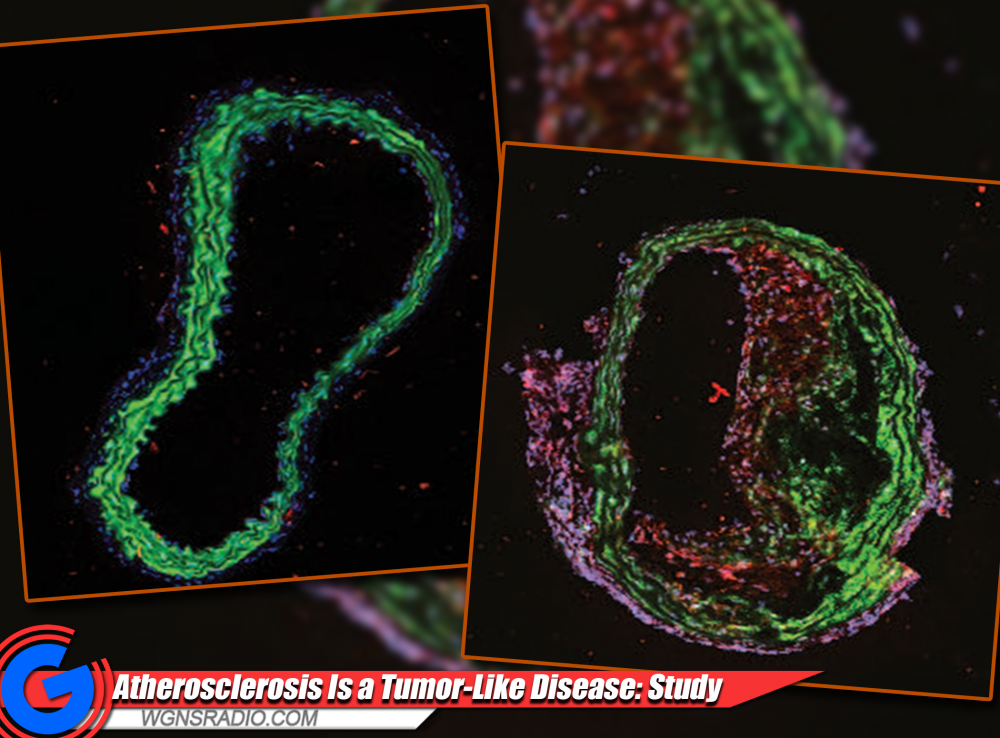PHOTO ABOVE ARTICLE: Artery sections with glowing green smooth muscle cells from a healthy mouse with no atherosclerosis (left) and from a mouse with atherosclerosis (right). The red/purple fluorescence in the atherosclerotic plaque marks cells with DNA damage. (image courtesy of Huize Pan, PhD)
The fatty plaques that build up inside arteries in the disease atherosclerosis have features in common with tumors.
In a study published April 30 in the journal Circulation, researchers demonstrated that blood vessel smooth muscle cells change their identity and behave like cancer cells. An anticancer drug blunted atherosclerosis progression — and even made plaques shrink — in a mouse model of the disease, opening new opportunities for preventing and treating atherosclerosis.
“Atherosclerosis has traditionally been considered a chronic inflammatory disease with a main cause being high levels of lipids,” said Huize Pan, PhD, assistant professor of Medicine at Vanderbilt University Medical Center and the first and co-corresponding author of the Circulation report. “Our discoveries add a new dimension to understanding the pathogenesis of atherosclerosis as a tumor-like disease.”
Atherosclerotic plaques cause arteries to narrow, reducing or blocking blood flow. Cardiovascular complications of atherosclerosis, such as heart attacks and strokes, are the leading cause of death worldwide.
Pan began studying the contribution of smooth muscle cells to atherosclerosis during his postdoctoral fellowship at Columbia University, where he worked with Muredach Reilly, MD, the senior and co-corresponding author of the current study.
Smooth muscle cells form the blood vessel “tube;” they contract and relax to regulate blood vessel volume and blood pressure. Accumulating evidence has suggested that a subset of vascular smooth muscle cells can change into other cell types that contribute to the development of atherosclerosis, Pan said.
“About two decades ago, researchers hypothesized that atherosclerosis is a tumor-like state of blood vessels, but that had not been systematically investigated until now,” he said.
To study the behavior of smooth muscle cells during the development of atherosclerosis, Pan and his colleagues developed a mouse model in which the vascular smooth muscle cells express a green fluorescent protein. The glowing green cells can be tracked even if they change their identity. The investigators also analyzed tissue samples from patients with atherosclerosis.
In the current study, the researchers demonstrated that smooth muscle cell-derived cells in atherosclerosis have multiple tumor-like characteristics including: genomic instability, hyperproliferation, resistance to cell death, invasiveness, and activation of cancer-associated signaling pathways. They showed that expression of a mutated KRAS gene (a driver of multiple types of cancer) in mouse vascular smooth muscle cells accelerated their change into other cell types and worsened atherosclerosis.
Treatment of atherosclerosis-prone mice with the anticancer drug niraparib during atherosclerosis progression reduced the size of developing plaques, and treatment of mice with already established atherosclerosis reduced plaque burden and improved measures of plaque stability.
The findings support further investigation to define the molecular mechanisms of smooth muscle cell transition in atherosclerosis, to identify somatic mutations that may be driving atherosclerosis, and to explore the potential for certain anticancer drugs to prevent and treat the disease. Such therapies would add to current treatments, including lipid-lowering drugs like statins, Pan said.
“Some patients who have normal lipid levels develop atherosclerosis, and other patients who undergo lipid-lowering therapy continue to have a high residual risk for cardiovascular disease, which both suggest that a high lipid level is not the only factor in the pathogenesis of atherosclerosis,” Pan said. “Our study gives a new perspective for understanding the disease — and for preventing and treating it.”
Pan joined the VUMC faculty in the Division of Cardiovascular Medicine earlier this year. The research was supported by the National Heart, Lung, and Blood Institute, part of the National Institutes of Health (grants K99HL153939, R00HL153939, R01HL166916, R01HL113147, R01HL150359, R01HL169766).





